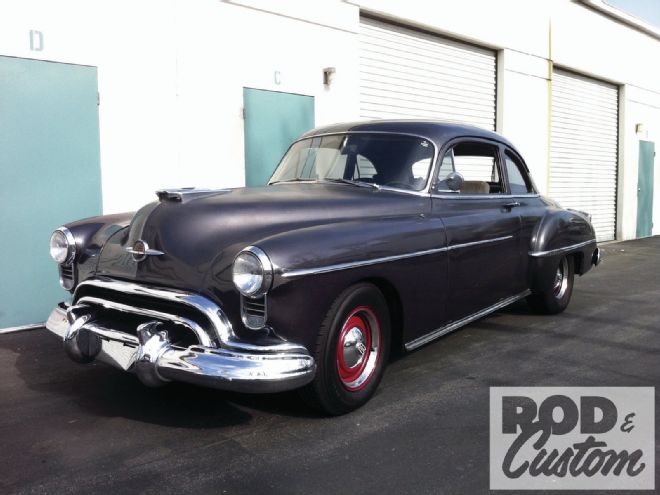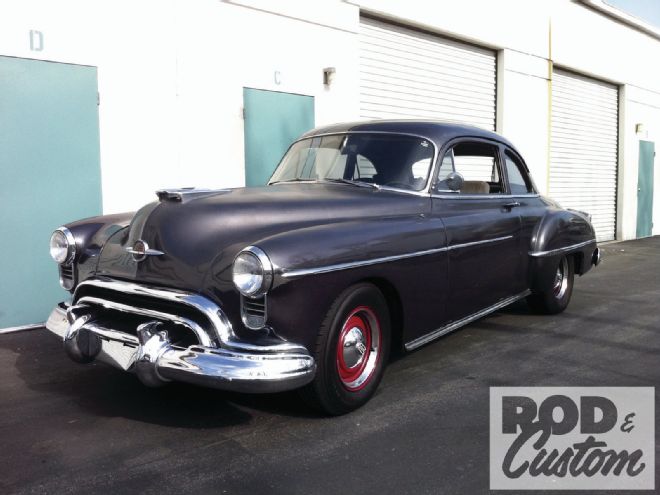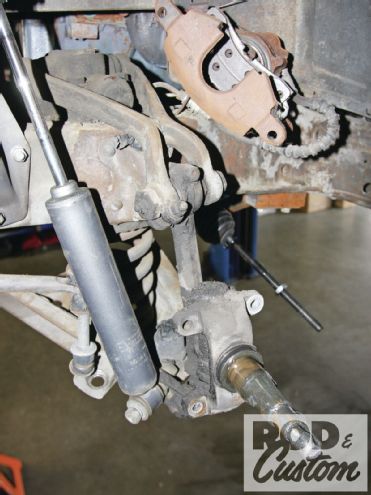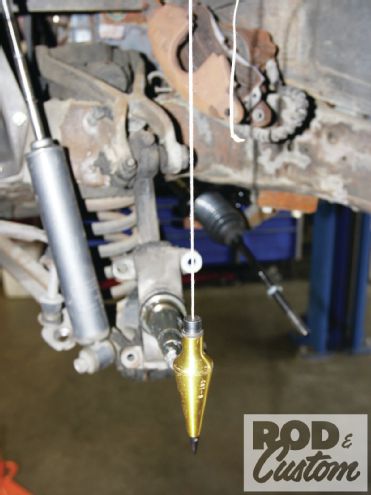

Cars built during the mid 20th century offered a vast improvement in steering and suspension over their predecessors of even 20 years earlier. Fast forward 50 or 60 years, however, and they’re woefully inadequate for today’s roads and highway speeds, especially when fitted with more modern engines and powertrains. While some lend themselves to easy suspension swaps (think of the myriad of Mustang II–based crossmembers and clips available in the aftermarket), others aren’t so easily adapted.
 1 Here’s the stock Olds suspension, though someone had previously added tube shocks, a steering rack with dubious geometry, and disc brakes. While adequate for highway speeds in the ’50s, this setup had negative caster, and the car would change lanes at freeway speeds.
1 Here’s the stock Olds suspension, though someone had previously added tube shocks, a steering rack with dubious geometry, and disc brakes. While adequate for highway speeds in the ’50s, this setup had negative caster, and the car would change lanes at freeway speeds.
This ’50 Olds is a perfect case in point. Jules Engoren bought this 455-powered coupe that already had a rack-and-pinion and disc brakes installed, yet he was less than enamored when it showed a tendency to swap lanes on the freeway at the sign of any slight deviation in the road surface. Zero (or even positive) caster made steering lighter in the days before power steering was common, and highway speeds were a lot slower back then. There is no way to adjust the caster on the Olds, yet the owner didn’t want to go to the expense and amount of work involved to “clip” the car.
Having had “Kiwi” Steve Davies of Kiwi Steve’s Hot Rod Shop in Brea, California, perform work on his ’34 phaeton in the past, he asked Davies if he could modernize the suspension and steering without resorting to a front frame swap. The Olds has a chassis that doesn’t lend itself easily to such a job, as the framerails are not parallel and the front crossmember is a hefty affair, to say the least.
 2 A plumb bob was hung from the front fender to determine where the centerline of the spindle was. The modifications will include moving the upper ball joint back and the lower forward when the CPP Chevelle spindles are installed, to correct the caster geometry, so establishing this baseline is important.
2 A plumb bob was hung from the front fender to determine where the centerline of the spindle was. The modifications will include moving the upper ball joint back and the lower forward when the CPP Chevelle spindles are installed, to correct the caster geometry, so establishing this baseline is important.
After a lot of trial and error, and much planning, the result is a vastly improved ride that instills driver confidence, not fear. It’s also an upgrade that could be performed with stock parts from other cars, though aftermarket upper control arms and spindles were used from Classic Performance Products, offering the benefit of improved strength with new parts.
However, before we get into the nitty-gritty of the swap, there are a couple of things to bear in mind. Firstly, this isn’t a job for a novice, as plenty of fabrication and a thorough understanding of suspension and steering geometry are required to complete the task. Secondly, this swap represents an improvement over the stock Olds components, not a perfect front suspension on this platform, as so much is inherently “wrong” to start with. It is, however, with the right knowledge and skills, easier than stripping the car and grafting in a front clip from the firewall forward, as the engine, transmission, sheetmetal, and bumpers don’t require removal and remounting. The use of Chevelle spindles means there is a vast selection of rotors and calipers that can be used, from stock versions all the way up to six-pot calipers and large-diameter vented rotors.
Wrapping Up ...
Though not part of the suspension, per se, there were a couple of associated jobs that were required to complete the project. As mentioned, this ’50 Olds has a 455/700-R4 combo, and with the starter on the left side, exhaust clearance and steering column routing posed a challenge. After trying four or five different manifolds from various Olds models, this version that kicked out toward the rear finally provided the necessary steering shaft clearance. A small section of tubing was then welded up, with flanges for ease of future maintenance. With the addition of power steering, the Olds required a power steering pump, but specifically one valved for a power rack, not a steering box. This old style, low pressure, Saginaw pump was sourced from a one-year-only Chevy Citation.